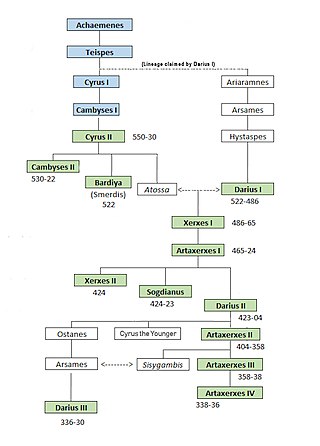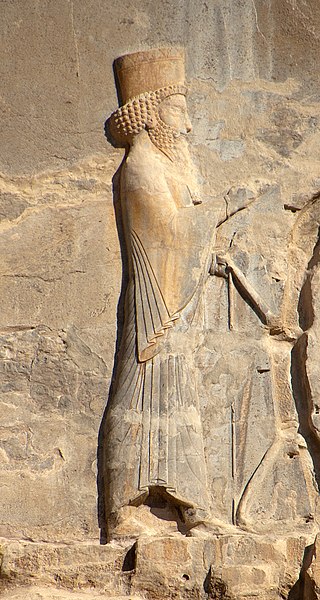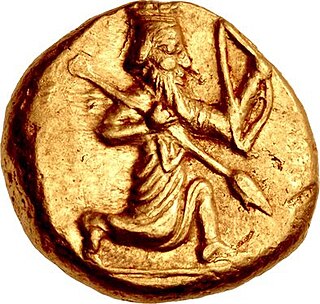
Xerxes I, commonly known as Xerxes the Great, was a Persian ruler who served as the fourth King of Kings of the Achaemenid Empire, reigning from 486 BC until his assassination in 465 BC. He was the son of Darius the Great and Atossa, a daughter of Cyrus the Great.

Darius II, also known by his given name Ochus, was King of Kings of the Achaemenid Empire from 423 BC to 405 or 404 BC.

Darius III was the thirteenth and last Achaemenid King of Kings of Persia, reigning from 336 BC to his death in 330 BC.

Tissaphernes was a Persian commander and statesman, Satrap of Lydia and Ionia. His life is mostly known from the works of Thucydides and Xenophon. According to Ctesias, he was the son of Hidarnes III and therefore, the great grandson of Hydarnes, one of the six conspirators who had supported the rise of Darius the Great.

Arses, known by his regnal name Artaxerxes II, was King of Kings of the Achaemenid Empire from 405/4 BC to 358 BC. He was the son and successor of Darius II and his mother was Parysatis.

Bessus or Bessos, also known by his throne name Artaxerxes V, was a Persian satrap of the eastern Achaemenid satrapy of Bactria, as well as the self-proclaimed King of Kings of the Achaemenid Empire from 330 to 329 BC.

Hyrcania is a historical region composed of the land south-east of the Caspian Sea in modern-day Iran and Turkmenistan, bound in the south by the Alborz mountain range and the Kopet Dag in the east.

Ochus, known by his dynastic name Artaxerxes III, was King of Kings of the Achaemenid Empire from 359/58 to 338 BC. He was the son and successor of Artaxerxes II and his mother was Stateira.

Sogdianus was briefly a ruler of the Achaemenid Empire for a period in 424–423 BC. His short rule—lasting not much more than six months—and the little recognition of his kingdom are known primarily from the writings of Ctesias; who is known to be unreliable. He was reportedly an illegitimate son of Artaxerxes I by his concubine Alogyne of Babylon.

Datames, also known as Tarkamuwa, was an Iranian military leader, who served as the governor (satrap) of the Achaemenid satrapy of Cappadocia from the 380s BC to 362 BC. A Carian by birth, he was the son of Camissares by a Paphlagonian mother. His father being satrap of Cilicia under Artaxerxes II, and high in the favour of that monarch, Datames became one of the king's bodyguards; and having in this capacity distinguished himself in the war against the Cadusii, was appointed to succeed his father in the government of his province. Here he distinguished himself both by his military abilities and his zeal in the service of the king; and reduced to subjection two officials who had revolted from Artaxerxes, Thyus, governor of Paphlagonia, and Aspis of Cataonia.

Ariarathes I was the last Achaemenid Persian governor (satrap) of the province (satrapy) of Northern Cappadocia, serving from the 340s BC to 331 BC. He led defensive efforts against the Macedonian invasion, commanded by Alexander the Great, and later fought at the Battle of Gaugamela under Darius III, the last King of Kings of the Achaemenid Empire. After the fall of the Achaemenid Empire, Ariarathes continued his resistance against the Macedonians, ruling concomitantly as an Achaemenid remnant and a precursor to the Kingdom of Cappadocia. He is regarded as the founder of the Iranian Ariarathid dynasty.

Media is a region of north-western Iran, best known for having been the political and cultural base of the Medes. During the Achaemenid period, it comprised present-day Iranian Azerbaijan, Iranian Kurdistan and western Tabaristan. As a satrapy under Achaemenid rule, it would eventually encompass a wider region, stretching to southern Dagestan in the north. However, after the wars of Alexander the Great, the northern parts were separated due to the Partition of Babylon and became known as Atropatene, while the remaining region became known as Lesser Media.
The Orontid dynasty, also known as the Eruandids or Eruandunis, ruled the Satrapy of Armenia until 330 BC and the Kingdom of Armenia from 321 BC to 200 BC. The Orontids ruled first as client kings or satraps of the Achaemenid Empire and after the collapse of the Achaemenid Empire established an independent kingdom. Later, a branch of the Orontids ruled as kings of Sophene and Commagene. They are the first of the three royal dynasties that successively ruled the ancient Kingdom of Armenia.

Drangiana or Zarangiana (Greek: Δραγγιανή, Drangianē; also attested in Old Western Iranian as 𐏀𐎼𐎣, Zraka or Zranka, was a historical region and administrative division of the Achaemenid Empire. This region comprises territory around Hamun Lake, wetlands in endorheic Sistan Basin on the Iran-Afghan border, and its primary watershed Helmand river in what is nowadays southwestern region of Afghanistan.

Carmania is a historical region that approximately corresponds to the current province of Kerman, Iran, and was a province of many Iranic empires such as Medes, Achaemenid, Seleucid, Parthian, and Sasanian Empire. The region bordered Persia proper & the Persian Gulf in the west, Makran & the Makran Sea in the south-east, Parthia in the north, and Aria to the northeast.

The Twenty-seventh Dynasty of Egypt, also known as the First Egyptian Satrapy, was a satrapy of the Achaemenid Empire between 525 and 404 BC. It was founded by Cambyses II, the King of Persia, after the Battle of Pelusium and the Achaemenid conquest of Egypt, and his subsequent crowning as Pharaoh of Egypt. It was disestablished upon the rebellion and crowning of Amyrtaeus as Pharaoh. A second period of Achaemenid rule in Egypt occurred under the Thirty-first Dynasty of Egypt.

Arsames was an Achaemenid satrap of ancient Egypt during the 5th century BC, at the time of the 27th Dynasty of Egypt.

The Achaemenid Empire or Achaemenian Empire, also known as the Persian Empire or First Persian Empire, was an Iranian empire founded by Cyrus the Great of the Achaemenid dynasty in 550 BC. Based in modern-day Iran, it was the largest empire by that point in history, spanning a total of 5.5 million square kilometres. The empire spanned from the Balkans and Egypt in the west, most of West Asia, the majority of Central Asia to the northeast, and the Indus Valley to the southeast.

Orontes I was a military officer of the Achaemenid Empire and satrap of Armenia at the end of the 5th-century BC and first half of the 4th-century BC. He is notable for having led the unsuccessful Great Satraps' Revolt in Asia Minor against the Achaemenids from 362/1 BC to 360/359 BC.

The Thirty-first Dynasty of Egypt, also known as the Second Egyptian Satrapy, was effectively a satrapy of the Achaemenid Persian Empire between 343 BC to 332 BC. It was founded by Artaxerxes III, the King of Persia, after his reconquest of Egypt and subsequent crowning as Pharaoh of Egypt, and was disestablished upon the conquest of Egypt by Alexander the Great.


















